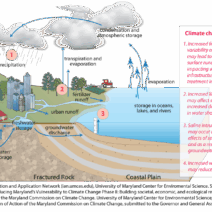La Niña, often positioned as the cool sibling of El Niño in the dynamic dichotomy of climate phenomena, has garnered increasing attention in recent years—not merely for its immediate weather impacts but for its intricate interplay with global warming. Understanding this relationship is crucial as the consequences extend far beyond typical weather patterns, affecting ecosystems, agricultural viability, and global weather systems.
The La Niña phenomenon is characterized by the cooling of sea surface temperatures in the central and eastern Pacific Ocean. This climatic occurrence influences atmospheric circulation patterns, which can lead to a range of weather anomalies. While La Niña is historically associated with enhanced rainfall in certain regions and drought in others, its interaction with climate change poses unique challenges and complexities.
One common observation regarding La Niña is its tendency to yield cooler global temperatures temporarily, often leading some to mistakenly assume that it counters the overarching trend of global warming. However, this perception barely scratches the surface of a more profound and convoluted relationship between these two climatic players. The cooling effect of a La Niña event is often dwarfed by the relentless upward trajectory of global temperatures driven by anthropogenic greenhouse gas emissions.
In exploring the consequences of La Niña within the context of climate change, it is essential to consider the various mechanisms at play. The phenomenon alters oceanic currents and catalyzes shifts in atmospheric pressure systems. These adjustments can exacerbate the impacts of climate change, particularly in regions already vulnerable to extreme weather events. For instance, in Southeast Asia and Australia, La Niña can lead to increased rainfall which, while beneficial in terms of alleviating drought, can also precipitate flooding and landslides, thus complicating recovery efforts and straining local communities.
Moreover, the relationship between La Niña and global warming can pivot on feedback mechanisms that further illuminate the phenomenon’s complexity. For instance, cooler ocean surface temperatures can influence the amount of heat absorbed by the oceans, affecting weather systems across the globe. When La Niña occurs, it typically leads to a strengthening of the trade winds, which can enhance upwelling—an oceanic process that brings nutrient-rich waters to the surface, supporting marine ecosystems. However, as ocean temperatures rise due to climate change, these interactions may become less predictable, potentially leading to the degradation of marine biodiversity.
Conversely, the ramifications of La Niña on agriculture and food security cannot be overlooked. In many areas, particularly those reliant on rain-fed agricultural systems, the cooler, wetter conditions can initially seem advantageous. However, prolonged periods of excessive rainfall can hinder crop yields, create a breeding ground for pests, and disrupt the entire food supply chain. This cycle illustrates an ironic twist; while efforts to mitigate climate change are underway, variations like La Niña may still result in increased agricultural volatility, challenging food systems and leaving communities vulnerable.
The phenomena’s interplay with global warming surfaces critical concerns about resilience and adaptation. As weather patterns become increasingly erratic, communities will need to develop strategies that accommodate not just the variability of La Niña but also the amplifying effects of climate change. This necessitates an integrated approach to climate resiliency that incorporates both short-term adaptation measures and long-term strategic planning.
Additionally, La Niña’s intricate relationship with climate change underscores the importance of scientific research and modeling. Enhancing predictive models can help elucidate how future La Niña events might manifest in a warming world. This knowledge is vital for policymakers, enabling them to adapt infrastructure and management practices in sectors such as water resources and disaster preparedness. Reliable forecasting can serve as an essential tool in preemptively addressing the challenges associated with climate variability.
It is also important to recognize the interconnectedness of climate systems and human activity. As the frequency and intensity of La Niña events may be influenced by the broader climate crisis, society faces the dual challenge of reducing emissions and preparing for the inevitable impacts of climate variability. This may involve investing in sustainable technologies, resilient agricultural practices, and comprehensive educational initiatives that cultivate a deeper understanding of climate dynamics among the public.
While La Niña’s effects may be cyclical and localized, the phenomenon’s relationship with global warming presents a broader, systemic issue. Disentangling this relationship not only sheds light on how different climate systems interact but also emphasizes the urgent need for coordinated global action. Climate change is not just a future concern but a current reality that demands immediate and sustained efforts from individuals, communities, and nations.
In conclusion, La Niña serves as a fascinating lens through which to view the intricacies of climate patterns amid the challenges of global warming. Understanding its dynamics offers valuable insights into how our planet’s climate system operates and highlights the necessity for comprehensive strategies to combat climate change. As we gather more data and refine our models, we must remain vigilant in addressing the nuances of these phenomena and their far-reaching implications for stewardship of our planet and its resources.





